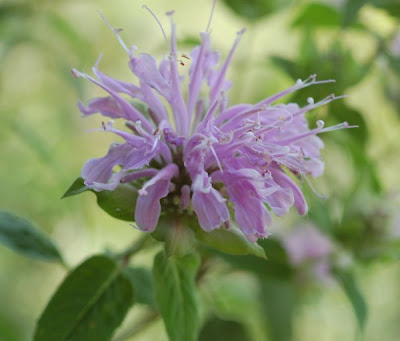
I learned this plant as "Horsemint," but it is called "Wild Bergamot" most often in field guides. It's also called "Oswego Tea" and "Bee Balm." Some links:
- Wild Bergamot Monarda fistulosa from the Connecticut Botanical Society.
- USDA Plants Profile for Monarda fistulosa L.. They provide this ethnobotanical information:
The Tewa Indians...cooked Wild bergamot with meat. The Iroquois used the plant in the making of a beverage....The Ojibwe put a wad of chewed leaves of this plant into their nostrils to relieve headache. The tops of the plant were dried and used as a sternutatory for the relief of colds. The leaves were placed in warm water baths for babies. The Flambeau Ojibwe gathered and dried the whole plant, boiling it in a vessel to obtain the volatile oil to inhale to cure catarrh and bronchial affections. The Menomini also used this plant as a remedy for catarrh, steeping the leaves and inflorescences in a tea. The Meskwaki used this plant in combination with other plants to relieve colds. The Hocak (Winnebago) used wild bergamot in their sweat bath and inhaled the fumes to cure colds. A decoction of boiled leaves was used as a cure for eruptions on the face. The Cherokee made a warm poultice of the plant to relieve a headache. The Teton Dakota boiled together the leaves and flowers as a cure for abdominal pains. The Blackfoot made a tea from the blossoms and leaves to cure stomach pains. They also applied boiled leaves to the pustules of acne. The Tewa dried the plant and ground it into a powder that was rubbed over the head to cure headaches, over the body to cure fever, and as a remedy for sore eyes and colds. Early white settlers used it as a diaphoretic and carminative, and occasionally employed it for the relief of flatulent colic, nausea and vomiting.
- Native Plant Database "Oswego Tea" entry from The Ladybird Johnson Wildflower Center
4 comments:
Bergamot is very common here in the Mississippi Valley. It seems to be one of those native plants which have adapted well to man-made disturbance, being common along roadsides as well as forest borders and moist prairie remnants.
My favorite mint-family native is Pycnanthemun pilosum, the Hairy Mountain Mint. It can be found in prairie remnants and neglected pastures, and it has a wonderfully pure minty odor. Good butterfly plant, too!
Wow thanks for the info. I have a bee balm plant in the garden. I just may have to try some of these remedies!!!
I have it in my garden. i refer to it both as bergamot and Oswego tea. It's just as good as beebalm for hummingbirds and insects, but tolerates drier and sunnier conditions.
It's thick going down the trail to the Falls of Hills Creek.
Post a Comment